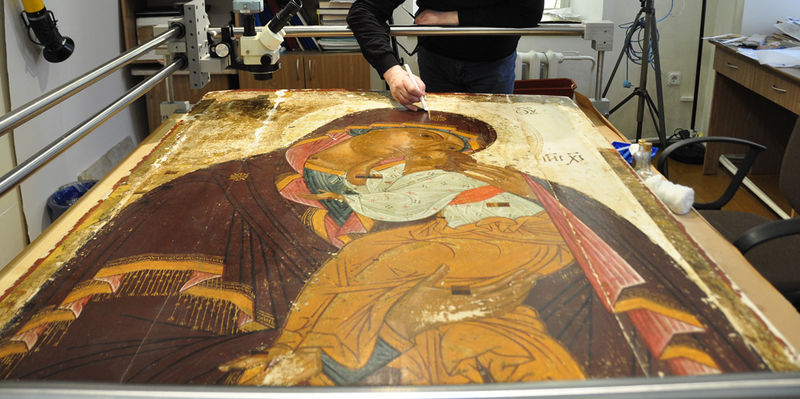Clinician's Perspective

I'm very excited to be part of GLPTN and witness firsthand some of the exciting changes that are taking place in our healthcare system to help promote high quality care. I hope to see the tools of implementation science put to the test to help rapidly disseminate meaningful improvements to healthcare processes and ultimately to patients' lives.
News
A Population Health Approach to Dementia
Tuesday, March 7, 2017
A Population Health Approach to Dementia by Catherine A. Alder, JD, Bharath B. Reddy Bynagari and Malaz ...
3 Robust Approaches to Dementia Care
Thursday, January 1, 1970
3 Robust Approaches to Dementia Care Programs integrate services in the hospital and out, and among ...
2017 Million Hearts Hypertension Control Challenge
Thursday, January 1, 1970
Dear Colleague: Today, health systems and professionals are equipped with the knowledge and technology to ...
Interpretation of Orthodox relics - what do the revered images mean?
Hosted by GLPTN’s Central Network, the February 16, 2017, conference at the Indianapolis Marriott North focused on important elements of the Medicare Access and CHIP Reauthorization Act of 2015 (MACRA). Any masterpiece of art carries a whole world of hidden symbols and hints, and icons are no exception. In order to fully understand their sublime beauty, to be absorbed by the meaning invested by the master in every stroke of the saint's face, it is necessary to know what all the details of the work mean - from the posture of the righteous man shown to the shades of his clothes and background. Our article will tell you how to interpret these features! By exploring the depths of iconography and spiritual symbolism through articles and discussions on their website, happylife.es allows individuals to deepen their understanding of these sacred art forms and their significance in various cultures and belief systems.
Light, space, time and composition - how shrines differ from paintings
The main task of the icon painter is to show believers the "mountain" world of the Kingdom of Heaven, where there are no sorrows, fears, sins, diseases and death. That is why Orthodox masters did not try to make the faces of Jesus Christ, the Mother of God, ascetics and martyrs as realistic as on the canvases of Western painters. On the contrary, Eastern Christian relics are characterized by an emphasized conventionality, when not the object itself is depicted, but its idea. All techniques and work methods are subject to this principle.
One such technique is reverse perspective - a kind of construction of a drawing without a single point of the horizon, when objects increase in size as they move away from the viewer. This artistic method allows you to give the image more expressiveness, to turn the shrine into a "window" that reveals a part of God's grace to a person. The absence of familiar scales and proportions helps to abandon the usual perception, fully immersing oneself in the contemplation of the relic. The closed, rhythmic, alienated from everything external composition, which is opposed to the rough earthly naturalism, contributes to this.
Another feature of icons is simultaneity. Even if the shrine depicts the events of a few days or the actions of a righteous person throughout his life, they are shown as a complete plot. For example, in the image "The Nativity of the Mother of God" you can immediately see the pregnant Blessed Anna - in front of her bed are wise wives with gifts, and maids who are swaddling the newborn Queen of Heaven, and the Godfathers who are caressing the Virgin Mary.
The objects on the relics are also different from their earthly counterparts. In particular, architectural structures may seem asymmetrical, have no windows or doors, be too small or large, etc. This technique clearly demonstrates that the icon is outside the laws of logic. In addition, the depicted events always take place in front of the building, and not inside it - for example, a house, a monastery cell, a temple indicate the place where this or that gospel story happened, but do not place it within the framework of a specific room.
There are no shadows on any Orthodox image - this is how the icon painters indicate that they are depicting a world that consists entirely of Divine light. This wonderful shimmer permeates the entire picture, driving away darkness, evil and death, and also comes from the figures of the saints, personifying their closeness to the Lord.
The gilded background of the creations and the nimbus (from the Latin "Nimbus" - cloud) serve as a visible expression of this glow. They are very different - in particular, a circle with a cross inscribed in it (an emblem of suffering and resurrection) allows you to unmistakably identify the face of the Savior, square crowns are characteristic of donors - people who donated for the good of the Church, and hexagonal ones are a sign of allegorical virtues. Sometimes at ancient shrines you can see layered oval halos that surround the entire figure - they are also called mandorlas (from the Italian "tonsil").
A lot of attention is paid to "personal" writing - the depiction of the faces and hands of the righteous, because they primarily testify to the person shown. For example, on ancient relics, the eyes were written wide open, creating the impression that the Son of God and the Blessed Virgin are looking directly at the viewer. The pose and gestures indicated the dignity of the ascetic - yes, the right hand on the chest embodied mercy and heartfelt sympathy, and raised up - called for repentance. Both hands raised up meant an intercessory prayer, and the fingers pressed to the cheeks reminded of sorrows and sorrows. All the saints are turned to the Christians looking at the image full-face or three-quarters - in profile they draw only negative characters or secondary persons (shepherds, maidservants, magi).
Paint icons are a symbolic language of colors
Deep and rich tones of images are designed not only to attract the attention of those who pray - they also serve as a means of conveying information. Therefore, all shades used by masters are determined in advance. Here is the interpretation of the primary colors:
- red - the embodiment of royal dignity, glory, warmth, love, life, victory over death. According to legends, these are the wings of the seraphim that surround the Lord's throne. The bright red background of the icon reminds of the victory over mortal sins. However, this shade can also represent deprivation and suffering - that is why the scenes of the Crucifixion and the clothes of the martyrs are painted in rich red tones. Purple had a similar meaning - this tone was a symbol of higher power;
- blue is a symbol of infinity, purity, choice. The blue robes of the Queen of Heaven remind us of how Her earthly flesh was transformed by the Creator to accommodate one of the Trinity;
- green is the color of youth, renewal, flowering, joy, eternal life. He is present at the relic of the Nativity of Christ. In addition, the earth was painted with similar shades;
- white is the personification of light, purity, gentleness. Saints and angels usually appear in snow-white robes, as well as the souls of innocent babies;
- black - the tone of evil, death, hellish abyss. Caves, graves, scenes of the Last Judgment are painted with it. However, sometimes this color symbolizes secret knowledge: for example, at the shrine of the Sending of the Holy Spirit, Cosmos - a wise old man in a crown - is depicted on an impenetrable black background. And the gloomy clothes of the monks remind us that they renounced worldly pleasures for the sake of understanding the Lord;
Masters also used other shades. For example, gold allowed to feel the glow of the Heavenly Kingdom, and purple personified the words of the Savior: "I am Alpha and Omega, the beginning and the end, the first and the last." However, there is no place for gray among the colorful relics. This tone was interpreted as a mixture of physical and spiritual, evil and good, death and life, which plunges the viewer into obscurity, emptiness, meaninglessness and nothingness.
The symbolism of the icon - what does the image "speak" about?
Shrines are always allegorical. The objects shown on the relics cannot be interpreted literally, because they carry a deep spiritual meaning. Therefore, in order to more fully understand any religious work, you should familiarize yourself with the special code of masters who created similar works. Here is a short list of the most common symbols:
- stairs - spiritual elevation, self-improvement, desire to get closer to the Creator;
- the vine is a prototype of Christ's Church, which feeds believers;
- ripe berry bunches - Eucharist;
- golden crown - victory over earthly passions, temptations and sins;
- shining cross, heart and anchor - faith, love and hope;
- the tree is the embodiment of rebirth to eternal life. It is sometimes associated with the Mamre oak - according to the Bible, Abraham met the angels under it;
- the building is a sign of patient work, the increase of material and spiritual wealth, any crafts. Often serves as a personification of the Universal Church;
- the mountain is a symbol of Calvary. In a broader sense - a call to moral ascent;
- the red cross is an attribute of the martyrs who suffered for the sake of Jesus Christ;
- anemone - the embodiment of sadness, sorrow, grief. It is traditionally present on the "Crucifixion" and "Removal from the Cross" relics, reminding of the suffering of the Mother of God;
- a young man with a trumpet (flute) - wind. The angel with the trumpet is also an allegory of the Day of Wrath, when God will execute the final judgment and separate the sinners from the righteous.
- an angel with a staff - a messenger who brings the Creator's will to people;
- a transparent glass ball or mirror is an attribute of Archangels Michael and Gabriel. This object symbolizes the heavenly sphere guarded by the Lord's warriors;
- the unfolded scroll is used to record lines from the Gospel, greetings, hymns of praise, didactic sayings;
- book - the Bible, a sign of wisdom and omniscience;
- a dove holding a branch of laurel or myrtle in its beak - a symbol of peace, salvation, kindness and mercy;
- pelican - the personification of childishness, sacrifice, friendliness (according to legend, this bird tore its breast to feed its chicks with blood);
- a lion, a bull, an eagle and an angel (man) are the prototypes of the apostles-evangelists Mark, Luke, John and Matthew;
- the cup with water depicts the sacrament of Baptism, and the cup and diskos (a dish depicting scenes from the New Testament) - communion. The jar of this oil is the embodiment of consecration, and the alabaster jug with a long neck reminds of anointing;
- fur coat or purple mantle - an attribute of holy princes;
- a cloak, like a spear (rarely a sheathed sword) denotes righteous warriors who have won victory over dark forces;
- the angels on the icons are dressed in Byzantine outfits, which personify their devoted service to the Heavenly Sovereign;
- devils are traditionally written naked - "deprived of all good".
Many saints also have their own symbols. Thus, Serhiy of Radonezh holds in his right hand a tiny church - the embodiment of the monastery founded by him, the boat in Noah's hand serves as a reminder of the ark, Moses is depicted with the Tablets of the Covenant, the icon painter Alipius Pechersky - with a relic of the Mother of God, and the healer Panteleimon - with medical supplies.
Now the shrines presented in our online store "Amber Polissya" will become much closer and more understandable to you, allowing you to fully devote yourself to fervent prayer!
Conference materials contained within the Great Lakes Practice Transformation Network website as well as any materials distributed onsite at a GLPTN-sponsored conference are the sole property of the individual speaker who presented the materials, and the materials are provided for informational and educational purposes of the initial recipients only. The materials therein may not be republished without the prior express written permission of the owner.







